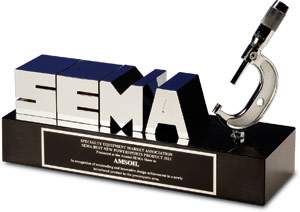Amsoil Performance Improver
AMSOIL Quickshot SE Awarded Best New Powersports Product by SEMA Judges
AMSOIL Quickshot SE Fuel Additive has been granted the Best New Powersports Product award for 2011 at the SEMA Show at the Las Vegas Convention Center. This year, over 2,000 new products were submitted for consideration of this distinctive honor in various categories. In determining the winners, judges looked for superiority of innovation, technical achievement, quality, consumer appeal and marketability. Amsoil Performance Improver
Treated Fuel Delivers Maximum Performance
AMSOIL P.i. is the most potent gasoline additive available today. As a concentrated detergent, it is unsurpassed in cleaning combustion chamber deposits, intake valve deposits and port fuel injector deposits. AMSOIL P.i. helps maintain peak engine efficiency, fuel economy, power and drivability in newer low mileage engines. In engines with accumulated deposits, testing showed AMSOIL P.i. provided the following clean-up benefits after only one tank of gasoline:
• Improves fuel mileage an average of 2.3% and up to 5.7%
• Reduced emissions
— hydrocarbons (HC) up to 15%
— carbon monoxide (CO) up to 26%
— nitrous oxides (NOx) up to 17%
• Restored power and performance
• Reduced need for costly higher octane fuel
• Reduced noise from carbon rap and pre-ignition
• Better drivability
• Smoother operation
AMSOIL P.i. works as an “emissions passer.” It is ideal for use prior to emissions inspections.
Unsurpassed Deposit Clean-up
Port Fuel Injector Deposits form after the engine has been shut down and there is no gasoline flowing through the injectors. During this “hot soak” period the injectors heat up and the gasoline remaining in the injectors degrades and forms deposits. This can happen very quickly with the use of poor quality gasoline and short trip driving. Because the clearances within the injectors are extremely tight and injectors must deliver precise amounts of “atomized” fuel, even small amounts of deposits can cause injectors to malfunction. Fuel flow is reduced and spray patterns are disrupted, decreasing engine efficiency, power and fuel economy, while increasing exhaust emissions. Amsoil Performance Improver
Amsoil Performance Improver

Amsoil Performance Improver
AMSOIL Quickshot SE is a premium fuel additive formulated to clean and restore optimal performance in small engine and powersports equipment fuel systems. It acts as a fuel stabilizer between uses and short-term storage and helps prevent damaging corrosion. Its revolutionary formulation focuses on three major fuel-related issues common in small engine equipment: ethanol, water and dirty gasoline.
Amsoil Performance Improver
AMSOIL Quickshot SE is designed to keep water dispersed throughout the fuel tank, moving it out and decreasing the chance of ethanol separating from the gasoline. Moisture finding its way into gas tanks through condensation is dispersed in tiny molecules and safely moved out of the tank through the combustion chamber. The lack of additives in today’s gasoline can cause fuel system gumming and varnish, creating deposits on critical components. AMSOIL Quickshot SE cleans hard to remove deposits on pistons, spark plugs, injectors, carburetors and other combustion chamber parts to maintain peak operating power.
AMSOIL Quickshot SE is recommended for use in all two-and four-stroke gasoline powered engines including motorcycles, snowmobiles, personal watercraft, boats, ATV’s, edgers, tillers, mowers, snow blowers, chain saws, generators and farm and construction equipment. Amsoil Performance Improver Amsoil Performance Improver Amsoil Performance Improver
Untreated Fuel Leads to Poor Engine Performance
A vehicle demonstrates its best efficiency and engine performance when it is new. As the engine ages, its performance suffers from gasoline fuel-generated deposits that form on the fuel injectors, intake valves and combustion chamber. Additives are required to control deposit formation.
Today’s fuels, however, lack sufficient treatments of either enough additives or high quality additives. Fuel system deposits result in the following:
• Lost fuel economy
• Lost power and poor throttle response
• Failed emission tests
• Poor drivability – surging, hesitation, stalling, rough idle
• Engine knocking (pinging) and rap
• Difficult starts
Treated Fuel Delivers Maximum Performance
AMSOIL P.i. is the most potent gasoline additive available today. As a concentrated detergent, it is unsurpassed in cleaning combustion chamber deposits, intake valve deposits and port fuel injector deposits. AMSOIL P.i. helps maintain peak engine efficiency, fuel economy, power and drivability in newer low mileage engines. In engines with accumulated deposits, testing showed AMSOIL P.i. provided the following clean-up benefits after only one tank of gasoline:
• Improves fuel mileage an average of 2.3% and up to 5.7%
• Reduced emissions
— hydrocarbons (HC) up to 15%
— carbon monoxide (CO) up to 26%
— nitrous oxides (NOx) up to 17%
• Restored power and performance
• Reduced need for costly higher octane fuel
• Reduced noise from carbon rap and pre-ignition
• Better drivability
• Smoother operation
AMSOIL P.i. works as an “emissions passer.” It is ideal for use prior to emissions inspections.
Unsurpassed Deposit Clean-up with Amsoil Performance Improver
Port Fuel Injector Deposits form after the engine has been shut down and there is no gasoline flowing through the injectors. During this “hot soak” period the injectors heat up and the gasoline remaining in the injectors degrades and forms deposits. This can happen very quickly with the use of poor quality gasoline and short trip driving. Because the clearances within the injectors are extremely tight and injectors must deliver precise amounts of “atomized” fuel, even small amounts of deposits can cause injectors to malfunction. Fuel flow is reduced and spray patterns are disrupted, decreasing engine efficiency, power and fuel economy, while increasing exhaust emissions.







